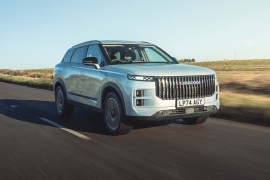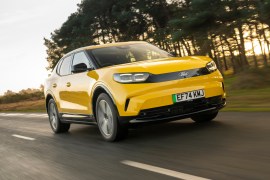Driving an electric Maserati on ice gave me new appreciation for driver aids
Heavy EVs make a strong case for ADAS tech once the snow falls

Driving during the chilly winter months can be tricky. Sitting behind the wheel of Maserati’s electric Grecale Folgore on a snow-covered ice track high up in the Italian mountains has the potential to be even more problematic. As it turns out, however, piloting a chunky EV with bucketloads of torque in a controlled environment well away from any potential obstacles is actually a blast.
The location was a specially created track on the outskirts of Livigno, deep in the Italian Alps and not far from the Swiss border. I’ve driven EVs on snow and ice before, but nothing quite as big as the 550bhp Grecale Folgore, which is an SUV of sizeable proportions. If traction control and driving aids are the sort of thing you frequently switch off as soon as possible, having them to hand in tricky conditions can be a very useful thing indeed – as I quickly found out come track time.
Before that, driving to the location from Bormio – the Italian town best known for its skiing championships and natural hot springs – on winding icy roads in a fleet of Masers was thankfully straightforward enough. The latest models are all armed with the latest driving aids to suit any kind of climate and condition. However, being able to open up the Grecale Folgore EV on a dedicated off-road track once we’d arrived was a revelation.



I last drove the Grecale Folgore on rather more sensible Italian roads last Spring and was impressed with its drivability and, naturally, comfort levels were high too. Scrunching through the snow and getting into the cockpit in this Alpine environment though was a different thing altogether. First up, I was given a demonstration lap around the short-but-sweet purpose-built track by a professional instructor to see the lie of the land. In the hands of an instructor it felt nimble and positively agile.
Unlike normally flat frozen lakes, the Ghiacciodromo Livigno is a more carefully crafted affair with lots of undulations added into the mix. So, instead of just skating sideways around corners, the track offered plenty of up and down sections to make controlling the car even more interesting. This is where the traction control side of things really came into play, wisely supplemented by a very worthy set of winter tyres. All very handy when the electric Maserati Grecale Folgore weighs a whopping 400 kilos more than its V6 petrol counterpart.
Starting off with the SUV in Sport mode and traction control on, the car didn’t let me go wild at all. In fact, it felt a bit flat as the power dissipated while the on-board systems got a little flummoxed by the crazy conditions. But, with traction control switched off, the Maserati Grecale Folgore was a bunch of fun. Of course, central to this is that extra weight, which means that when you head for a corner and pull the same manoeuvre as in the petrol edition, the heft of that battery pack is enough to pull the car into a spin.
Naturally, this is a lot of fun but it also underlines just how much the extra weight of EVs can make them a lot more unpredictable if the road conditions aren’t quite what you’re expecting. Something that I think is well worth remembering when driving an electric car on the road in winter weather.


I also got to drive the Maserati GranTurismo Folgore around the frozen track. This low-slung, all-electric sports car is armed with three 300kW electric motors powered by a 92.5kWh battery.
Out on regular roads, this thing will get from zero to sixty in just 2.7 seconds and claims a top speed of 202mph. On a frozen track, the GranTurismo is a different kettle of fish, but no less able thanks to the trio of electric motors. Two at the back and one at the front mean the car feels incredibly agile, while the on-board tech helps distribute the power without it ever feeling like an unmanageable handful.
With GT mode selected and electronic stability control doing its best, the Maserati felt more than manageable. Again though, turning the systems off and engaging Sport mode meant there was a lot more fun to be had, but things got very unpredictable too.
Of course, the reality of driving these cars on ice means that I was never actually going all that fast, but it certainly felt fast enough. These are heavy cars and, with all those batteries and luxury accoutrements on-board, once the momentum starts it’s very hard to keep either of them going in the desired direction.
While I may not have set any lap records, the two cars presented me with plenty of scenarios where not disabling driving aids is a very good idea indeed. If you ever get the chance, I suggest you do the same thing – but just be sure to do it on a track in carefully controlled surroundings, not on public roads. And remember that weight!


